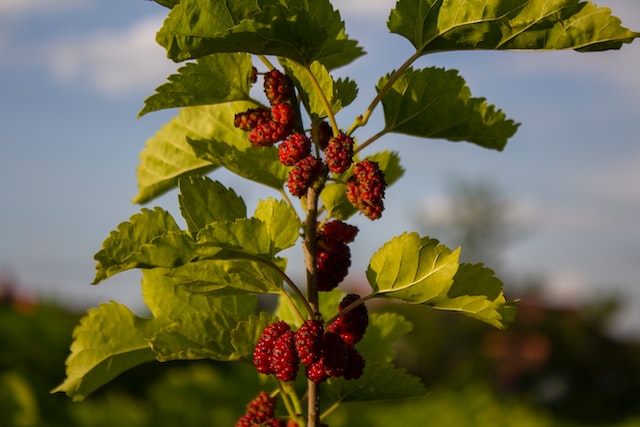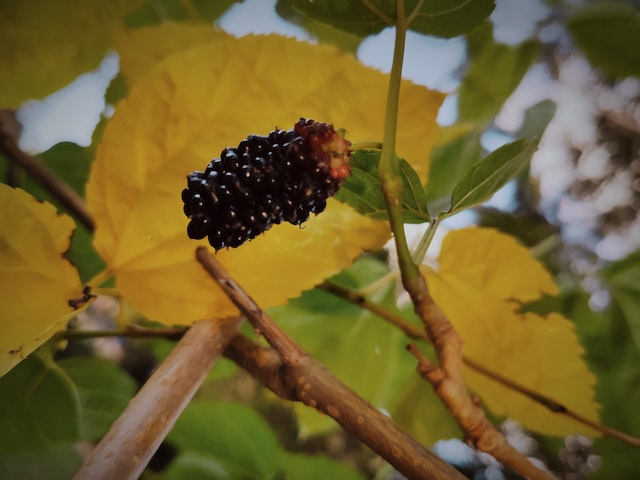Experience the Sweetness of Fresh Mulberries
Mulberry: A Sweet and Versatile Wonder of Nature
Introduction: Mulberry, with its sweet and succulent flavor, is a beloved fruit that has been cherished for thousands of years. This versatile and nutritious berry not only delights our taste buds but also finds its way into various other aspects of human life. From inspiring perfumers with its fragrance to offering potential therapeutic properties in essential oils and traditional medicine, mulberry is a true wonder of nature. Additionally, its historical significance in food culture and some fun and crazy facts add to its allure. This essay explores the captivating world of mulberry, encompassing its presence in perfumes, therapeutic oils, food, medicine, and uncovering some fascinating and fun facts about this delightful and versatile fruit.
Historical Significance and Culinary Heritage: Mulberries have a rich history, believed to have originated in China thousands of years ago. The fruit spread along the Silk Road, reaching various regions of Asia and Europe. Ancient civilizations, such as those in China and Persia, prized mulberries for their sweet taste and nutritional value. Mulberries were traditionally used in jams, preserves, and other culinary creations. Today, mulberries are enjoyed fresh, dried, or used in various dishes and desserts, showcasing their versatility in modern cuisine.
Perfumes and Fragrance: While mulberry essential oil is not commonly available, perfumers may use synthetic compounds to recreate its fragrance. Mulberry's scent is often described as sweet and fruity, reminiscent of its delicious taste. Its aromatic appeal has inspired some niche and limited-edition fragrances, adding a touch of sweetness and natural allure to the compositions.
Therapeutic Oils and Aromatherapy: Mulberry essential oil is not widely used in aromatherapy; however, mulberry leaves are occasionally used to extract oil with potential health benefits. Mulberry leaf oil is rich in compounds like polyphenols and flavonoids, which have antioxidant and anti-inflammatory properties. This makes it beneficial for skincare formulations, supporting skin health and reducing oxidative stress.
Culinary Delights: Mulberries are celebrated for their sweet and juicy flavor, making them a popular addition to an array of culinary creations. The berries are commonly enjoyed fresh, often used in fruit salads, smoothies, and desserts. Dried mulberries are a nutritious and tasty snack, commonly added to granola, trail mix, and baked goods. Mulberry preserves, sauces, and syrups are also used to enhance the flavor of various dishes.
Medicinal Applications: In traditional medicine systems like Chinese and Ayurvedic medicine, mulberry has been used for its potential health benefits. The fruit is considered nutritious, containing vitamins, minerals, and antioxidants. Mulberry leaves are also used to make herbal teas and extracts that are believed to support blood sugar regulation and promote overall well-being.
Fun and Crazy Facts:
Mulberry, with its sweet and versatile nature, is a wonder of nature that has been treasured across cultures and throughout history. From inspiring perfumers with its fragrance to offering potential health benefits in therapeutic oils and traditional medicine, mulberry's versatility is truly remarkable. Its historical significance in food culture and some fun and crazy facts add to its allure as a delightful and cherished fruit. As we savor the sweet and succulent delight of mulberry, we are reminded of the abundant wonders of nature and the nourishment it provides, enriching our lives in delightful and meaningful ways.
Introduction: Mulberry, with its sweet and succulent flavor, is a beloved fruit that has been cherished for thousands of years. This versatile and nutritious berry not only delights our taste buds but also finds its way into various other aspects of human life. From inspiring perfumers with its fragrance to offering potential therapeutic properties in essential oils and traditional medicine, mulberry is a true wonder of nature. Additionally, its historical significance in food culture and some fun and crazy facts add to its allure. This essay explores the captivating world of mulberry, encompassing its presence in perfumes, therapeutic oils, food, medicine, and uncovering some fascinating and fun facts about this delightful and versatile fruit.
Historical Significance and Culinary Heritage: Mulberries have a rich history, believed to have originated in China thousands of years ago. The fruit spread along the Silk Road, reaching various regions of Asia and Europe. Ancient civilizations, such as those in China and Persia, prized mulberries for their sweet taste and nutritional value. Mulberries were traditionally used in jams, preserves, and other culinary creations. Today, mulberries are enjoyed fresh, dried, or used in various dishes and desserts, showcasing their versatility in modern cuisine.
Perfumes and Fragrance: While mulberry essential oil is not commonly available, perfumers may use synthetic compounds to recreate its fragrance. Mulberry's scent is often described as sweet and fruity, reminiscent of its delicious taste. Its aromatic appeal has inspired some niche and limited-edition fragrances, adding a touch of sweetness and natural allure to the compositions.
Therapeutic Oils and Aromatherapy: Mulberry essential oil is not widely used in aromatherapy; however, mulberry leaves are occasionally used to extract oil with potential health benefits. Mulberry leaf oil is rich in compounds like polyphenols and flavonoids, which have antioxidant and anti-inflammatory properties. This makes it beneficial for skincare formulations, supporting skin health and reducing oxidative stress.
Culinary Delights: Mulberries are celebrated for their sweet and juicy flavor, making them a popular addition to an array of culinary creations. The berries are commonly enjoyed fresh, often used in fruit salads, smoothies, and desserts. Dried mulberries are a nutritious and tasty snack, commonly added to granola, trail mix, and baked goods. Mulberry preserves, sauces, and syrups are also used to enhance the flavor of various dishes.
Medicinal Applications: In traditional medicine systems like Chinese and Ayurvedic medicine, mulberry has been used for its potential health benefits. The fruit is considered nutritious, containing vitamins, minerals, and antioxidants. Mulberry leaves are also used to make herbal teas and extracts that are believed to support blood sugar regulation and promote overall well-being.
Fun and Crazy Facts:
- White and Black Mulberries: There are different varieties of mulberries, with the two most common being white mulberries and black mulberries. White mulberries are generally sweeter, while black mulberries have a richer and more complex flavor.
- Silkworm Connection: Mulberry leaves are the primary food source for silkworms, which are used in the silk production process. The leaves' role in sericulture makes them an essential part of the silk industry.
- Mulberry Stains: Mulberries have a reputation for staining clothes and fingers due to their dark pigmentation. This characteristic is often seen as a delightful reminder of the fruit's natural color.
- Mulberry Tree Longevity: Mulberry trees are known for their longevity, with some species living for several centuries. Their long life and delicious fruit have made them cherished additions to gardens and landscapes.
- Mulberry Wine: In some regions, mulberries are used to make mulberry wine, a sweet and flavorful beverage appreciated by wine enthusiasts.
Mulberry, with its sweet and versatile nature, is a wonder of nature that has been treasured across cultures and throughout history. From inspiring perfumers with its fragrance to offering potential health benefits in therapeutic oils and traditional medicine, mulberry's versatility is truly remarkable. Its historical significance in food culture and some fun and crazy facts add to its allure as a delightful and cherished fruit. As we savor the sweet and succulent delight of mulberry, we are reminded of the abundant wonders of nature and the nourishment it provides, enriching our lives in delightful and meaningful ways.
To experience augmented reality, please open the Facebook-app using QR code and point to the image below
Nutrient-Packed and Flavorful Berries
Mulberry is a type of deciduous tree or shrub that is native to many parts of the world. It is known for its edible fruit, which is similar in appearance to a blackberry or raspberry. The most commonly cultivated species is the white mulberry (Morus alba), which is native to China and is the primary food source for silkworms. The black mulberry (Morus nigra) is also cultivated for its fruit and is native to western Asia. Mulberries can also be used to make jams, jellies, and wine.
The mulberry tree has a long history of cultivation, dating back thousands of years. The ancient Chinese and Egyptians were among the first to cultivate the tree for its fruit and for use in silk production. The white mulberry (Morus alba) was brought to the United States in the 1700s in an effort to establish a silk industry, but the project was ultimately unsuccessful.
Mulberries have been cultivated in Asia for thousands of years. They were also grown in ancient Egypt, Greece and Rome. The leaves of the white mulberry were also used to feed silkworms, which were domesticated in China around 4500 years ago.
In the West, the black mulberry was widely grown in monasteries during the Middle Ages and was also used to feed silkworms. It was brought to the Americas by colonists in the 1600s and 1700s, and is still grown today for its fruit and as an ornamental plant.
Overall, the mulberry tree has a long history of both practical and cultural uses, and continues to be cultivated for its fruit and for use in silk production around the world.
Mulberries have been cultivated in Asia for thousands of years. They were also grown in ancient Egypt, Greece and Rome. The leaves of the white mulberry were also used to feed silkworms, which were domesticated in China around 4500 years ago.
In the West, the black mulberry was widely grown in monasteries during the Middle Ages and was also used to feed silkworms. It was brought to the Americas by colonists in the 1600s and 1700s, and is still grown today for its fruit and as an ornamental plant.
Overall, the mulberry tree has a long history of both practical and cultural uses, and continues to be cultivated for its fruit and for use in silk production around the world.
Delicious Mulberry Products at Scentopia
Mulberry fun fact:
- Mulberries are a rich source of nutrients, including vitamins C, K, and E, as well as antioxidants.
- The fruit of the white mulberry tree is sweeter than that of the black mulberry, but the black mulberry is considered to be of better quality and taste.
- Some species of mulberry tree can grow up to 50 feet tall.
- The wood of the mulberry tree is often used to make furniture, bowls, and other items.
- The leaves of the mulberry tree are used to feed silkworms, which spin a silk cocoon that is used to make silk fabric.
- Mulberries have been used in traditional medicine for centuries, and are believed to have anti-inflammatory, antioxidant, and anti-cancer properties.
- Mulberries are also known for their antibacterial, antifungal, and antiviral properties.
- The leaves of the mulberry tree turn yellow in autumn, adding to the tree's ornamental value.
- The fruit of the mulberry tree is a popular ingredient in pies, jams, jellies, and other desserts.
- The mulberry tree is also known as the "Moros" tree, which means "mortal" in Greek, because it was believed that the tree's fruit could grant immortality.
Immerse Yourself in a Berry-Picking Adventure
The scent of mulberries can vary depending on the species and variety of the tree. The white mulberry (Morus alba) has a sweet, mild smell, while the black mulberry (Morus nigra) has a more intense, sweet aroma.
The fruit of the mulberry tree also has a distinct smell, which is often described as sweet and slightly musky.
In perfumery, the mulberry fruit and leaves are not used as a raw material but the Mulberry tree bark has a unique smell and is often used as a fixative in perfumery. It is used to add a subtle woody and slightly spicy note to perfumes, and it is often used in combination with other ingredients to create a complex, layered scent.
Overall, the scent of the mulberry tree and its fruit is generally considered to be pleasant and sweet, making it a popular choice for use in perfumes and other scented products.
The fruit of the mulberry tree also has a distinct smell, which is often described as sweet and slightly musky.
In perfumery, the mulberry fruit and leaves are not used as a raw material but the Mulberry tree bark has a unique smell and is often used as a fixative in perfumery. It is used to add a subtle woody and slightly spicy note to perfumes, and it is often used in combination with other ingredients to create a complex, layered scent.
Overall, the scent of the mulberry tree and its fruit is generally considered to be pleasant and sweet, making it a popular choice for use in perfumes and other scented products.
Fresh and Juicy Mulberries for Your Palate
There are several famous brands that have used Mulberry in their perfumes, however, I couldn't find any specific brand that exclusively uses Mulberry as the main raw material. Mulberry is not a common ingredient in perfumery, it is mostly used as a fixative.
But, some well-known brands that have used Mulberry in their perfumes include:
But, some well-known brands that have used Mulberry in their perfumes include:
- Jo Malone: They have a line of perfumes that have used Mulberry as a note.
- The Body Shop: They have a line of perfumes that have used Mulberry as a note.
- Le Labo: They have a perfume "Ambrette 9" that has Mulberry as a note.
- Tom Ford: They have a perfume "Black Orchid" that has Mulberry as a note.
Scentopia's Commitment to Quality Berry Products
The scent of mulberries is often described as sweet, rich, and slightly fruity. Mulberries are known for having a unique and delightful aroma that can vary in intensity based on factors such as the variety of mulberry, its ripeness, and environmental conditions.
The scent of ripe mulberries is reminiscent of a mix between raspberries and blackberries, with a hint of floral notes. It's often considered quite pleasant and can evoke feelings of nostalgia, especially if you've had the chance to pick and eat fresh mulberries from a tree.
As with any natural scent, individual perceptions can vary, but many people find the scent of mulberries to be inviting and enjoyable.
The scent of ripe mulberries is reminiscent of a mix between raspberries and blackberries, with a hint of floral notes. It's often considered quite pleasant and can evoke feelings of nostalgia, especially if you've had the chance to pick and eat fresh mulberries from a tree.
As with any natural scent, individual perceptions can vary, but many people find the scent of mulberries to be inviting and enjoyable.
Join Scentopia, Sentosa's latest tourist attraction wonderful orchid scent crafting, fragrance tour, bridal shower or corporate team building which includes perfume making onsite and offsite, beach activities and more. We also serve primary school learning journey, secondary students and pupil on industrial excursions. Know more about our orchids perfume bar or therapeutic orchid scents and other wellness aromas. Conatct Perfume workshop or book a scent crafting session here.






